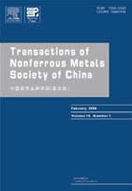Effects of hydrogen on fatigue life of
Ti-4Al-2V titanium alloy
Ti-4Al-2V titanium alloy
(1.Department of Metallic Material, Sichuan University,
Chengdu 610061, China;
2.Metallurgical Department, Chengdu Aircraft Industrial (Group) Corporation,Chengdu 610092, China;
3.State Main Laboratory of Nuclear Power Institute of China,
Chengdu 610041, China)
Chengdu 610061, China;
2.Metallurgical Department, Chengdu Aircraft Industrial (Group) Corporation,Chengdu 610092, China;
3.State Main Laboratory of Nuclear Power Institute of China,
Chengdu 610041, China)
Abstract: Four hydrogen contents were employed to investigate the effects of hydrogen on fatigue life of Ti-4Al-2V titanium alloy by means of section-varied samples. Results reveal that the fatigue life of the materials with (116~280)×10-6 hydrogen is higher than that of natural hydrogen material provided that the fatigue load Δσ is over 550MPa. At higher Δσ, the content of hydrogen has small effects on fatigue life within (116-280)×10-6 hydrogen. For material containing 280×10-6 hydrogen, fatigue cracks tend to initiate at sample edges at higher load, in contrast, to initiate at sites of hydrides at lower load. The interstitial hydrogen atoms softening the persistent slip bands(PSB) and hydrides separating from the body become the cause of decrease in fatigue life. Hydrides resolved into the body is observed at lower Δσ for material with 280×10-6 hydrogen, which is the result of concentration of hydrogen atoms at crack tips and stress-induced re-precipitation of hydrides.
Key words: titanium alloy; fatigue fracture; hydrogen; hydride

